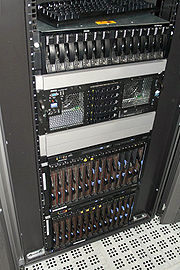Internet protocols

The complex communications infrastructure of the Internet consists of its hardware components and a system of software layers that control various aspects of the architecture. While the hardware can often be used to support other software systems, it is the design and the rigorous standardization process of the software architecture that characterizes the Internet.
The responsibility for the architectural design of the Internet software systems has been delegated to the Internet Engineering Task Force (IETF).[9] The IETF conducts standard-setting work groups, open to any individual, about the various aspects of Internet architecture. Resulting discussions and final standards are published in Request for Comments (RFCs), freely available on the IETF web site.
The principal methods of networking that enable the Internet are contained in a series of RFCs that constitute the Internet Standards. These standards describe a system known as the Internet Protocol Suite. This is a model architecture that divides methods into a layered system of protocols (RFC 1122, RFC 1123). The layers correspond to the environment or scope in which their services operate. At the top is the space (Application Layer) of the software application, e.g., a web browser application, and just below it is the Transport Layer which connects applications on different hosts via the network (e.g., client-server model). The underlying network consists of two layers: the Internet Layer which enables computers to connect to one-another via intermediate (transit) networks and thus is the layer that establishes internetworking and the Internet, and lastly, at the bottom, is a software layer that provides connectivity between hosts on the same local link (therefor called Link Layer), e.g., a local area network (LAN) or a dial-up connection. This model is also known as the TCP/IP model of networking. While other models have been developed, such as the Open Systems Interconnection (OSI) model, they are not compatible in the details of description, nor implementation.
The most prominent component of the Internet model is the Internet Protocol (IP) which provides addressing systems for computers on the Internet and facilitates the internetworking of networks. IP Version 4 (IPv4) is the initial version used on the first generation of the today's Internet and is still in dominant use. It was designed to address up to ~4.3 billion (109) Internet hosts. However, the explosive growth of the Internet has led to IPv4 address exhaustion. A new protocol version, IPv6, was developed which provides vastly larger addressing capabilities and more efficient routing of data traffic. IPv6 is currently in commercial deployment phase around the world.
IPv6 is not interoperable with IPv4. It essentially establishes a "parallel" version of the Internet not accessible with IPv4 software. This means software upgrades are necessary for every networking device that needs to communicate on the IPv6 Internet. Most modern computer operating systems are already converted to operate with both versions of the Internet Protocol. Network infrastructures, however, are still lagging in this development.
0 comments:
Posting Komentar